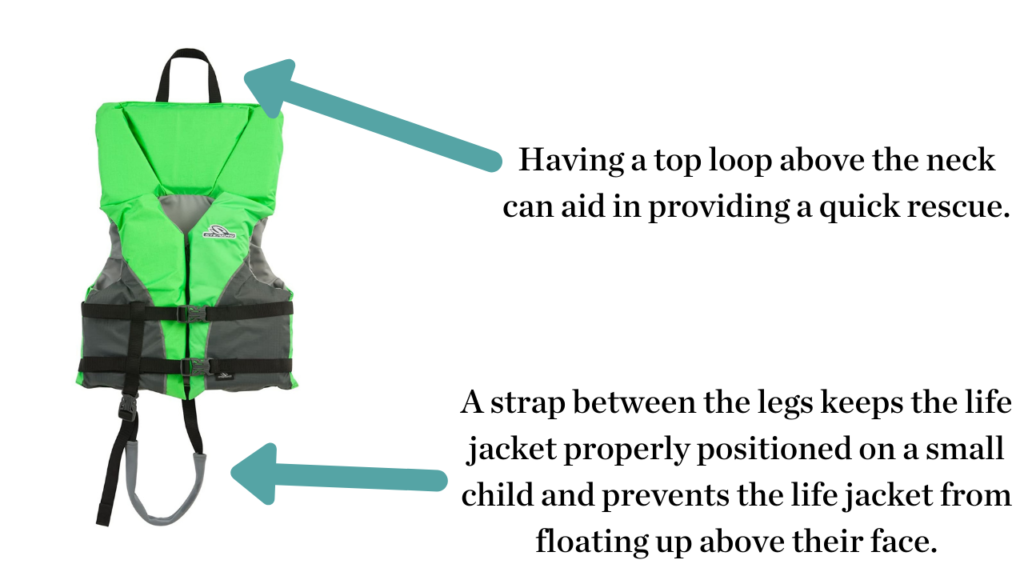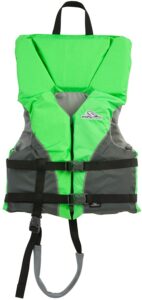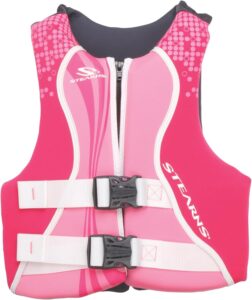Picking a life jacket for your baby or toddler can be an overwhelming process.
Here's what you need to know before you shop:
According to the Centers for Disease Control and Prevention (CDC), it’s estimated that at least two children die EVERY day in the US due to accidental drowning. This number is naturally higher in summer months.
Here where I live, in British Columbia, we’re surrounded by beautiful lakes and oceans. Unfortunately, every summer accidental drowning stories fill our local news headlines regularly. Most of these drownings happen in calm waters, when children lack proper supervision (usually unintentionally).
From one parent to another – please hear me out: when more than one adult gets together, we subconsciously tend to let down our guard down when it comes to supervision. Even unintentionally, it’s easy to assume that if there’s multiple pairs of eyes that someone will notice a drowning incident if one were to occur. It’s scenarios like this where we see tragedies, and it’s one of the reasons that we have lifeguards at swimming pools – even with multiple adults present, is anyone really paying close attention?
One of the easiest ways to prevent this from happening is to designate a water supervisor. Call someone out verbally. Make them wear a whistle. Whatever it takes for someone to know they’re “on duty”.
The drowning prevention advice for small children remains: when a small child is in our around water, bath-pool-lake-ocean, the best form of supervision is to always be within arm’s reach.
Okay, so that out of the way – let’s chat choosing a lifejacket.
First: Where are you planning to use the life jacket?
The US Coast Guard (USCG) has 5 types of approved life jackets. For children, types I-III are approved*. However, it’s not just that simple – there are factors we need to consider before choosing a type.
*See notes about infants, specifically, below.
Type I: an off-shore life jacket
Type I lifejackets are inherently buoyant (very, very “floaty”) and designed to turn unconscious people face-up in the water.
They are best used for situations such as boating on rough waters, open ocean (where you could encounter rough waters) or if you’re going somewhere remote where a quickly rescue is unlikely to happen.
The downside to these lifejackets are that they are very bulky, making many children hesitant to wear them or uncomfortable.
Type II: a near-shore buoyant vest-style life jacket
This type of life jacket is recommended by the USCG for infants, as they tend to provide more head support and more floatation support.
Type II life jackets are designed for calm (inland) bodies of water, or general/light boating where a quick rescue is possible if necessary. They aren’t designed for rough waters and the USCG recommends strongly against taking an infant on rough waters.
Type II life jackets are less bulky than Type I life jackets, but they will not always reliably turn a child face-up in the water.
Type III: "Flotation Aid" life jacket
This type of life jacket is recommended by the USCG only for older children who have solid swimming skills.
Type III lifejackets are typically much lighter weight (and generally more comfortable, for this reason) but are designed for use on calm (inland) waters, only.
They are not designed to turn children face-up in the water, and should not be used on open sea or rough waters.
Second: What design is best?
There are three main designs of life jackets to choose from:
A naturally buoyant life jacket
These lifejackets are typically made of a dense, floatable foam or neoprene. They require no special technique or action by the child for the lifejacket to do its job.
An inflatable life jacket
Inflatable life jackets come in two styles: some that inflate automatically when they enter the water (and therefore shouldn’t be used if going in the water frequently is intended), and some that are manually inflated.
However, these require regular maintenance to ensure they are in proper working order.
Because there is a chance of failure with this type, inflatable life jackets are not approved by the USCG for children under age 16, and not recommended for non-swimmers.
A "hybrid" life jacket
Hybrid life jackets are made up of both buoyant materials (such a foam or neoprene) and also include an inflatable chamber of some sort. Again, anything with an inflatable chamber will require some maintenance to ensure it is still functioning effectively.
They do tend to be less bulky than the purely buoyant life jackets, and can be more comfortable for longer wear on the water. This is generally a great “gateway” choice for life jacket-hesitant people.
Third: What important features am I looking for?
When looking for a life jacket for a small child, the main features to look for are:
1. The life jacket should be USCG approved*
… and if possible, tested by Underwriter’s Laboratory (UL) for extra peace-of-mind.
Now for an important note about infant life jackets, specifically:
The USCG advises against taking infants on recreational boats unless parents can test their baby in a life jacket sized appropriately for their infant, in a safe environment like a swimming pool, first. We need to know first that the lifejacket will properly fit the infant, not ride up above their face before we attempt a more risky water activity. See below for some testing examples.
2. The life jacket must be appropriate for the child's size and weight
It’s important not to buy something larger assuming a child will “grow into” their life jacket. In order for the life jacket to do its job now, it needs to fit them properly now. Check the labelling on the packaging carefully for sizing information.
3. For small children, look for these additional safety features:
Look for a life jacket with a loop at the back of the neck, and strap between the legs.
The loop is there in case you need to pull them out of the water.
The leg strap ensures small children can’t slip out of the life jacket. A properly fitted strap between the legs helps prevent the chin and ears from slipping into the life jacket in this scenario.
Life jackets with neck collars can provide more head support for infants and toddlers.

Okay, but, how can I be sure it fits my child properly?
Here are some simple ways to know if a life jacket is fitting a child properly:
- Based on the product labels, does the life jacket match your child’s size and weight?
- Have you properly fastened and cinched the life jacket to the child per the instructions, ensuring a snug, secure fit?
- Once the child is in the life jacket, have your child raise their arms above their head and pull up on the shoulder area. If the lifejacket rides up over the face (their chin or ears disappear into the life jacket, or the life jacket covers their nose/mouth) then the life jacket is not fitting them properly. Check to see if you can make adjustments, and if not, the life jacket is likely too big. On the flip side, if you can’t buckle or zip up the life jacket, it’s probably too small.
It’s important to let your child practice swimming with a life jacket in a calm, safe environment (such as a swimming pool) to get used to how it feels, before you venture out on open water.
Bottom line?
Life jackets only work when we wear them.
Life jackets are not a substitute for supervision.
Everyone in the family, parents included, should wear a life jacket when on open water.
You can check out my recommended products list for my favourite life jackets, here:




5 Comments on How do I pick a life jacket for my baby or toddler?
Hi Holly, I’m wondering about these “infant” pfds that I’ve seen online…are they not recommended?
https://www.sportchek.ca/categories/shop-by-sport/camping-equipment/paddle-boards-boats/pfd/product/level-6-infants-puffer-pfd-color-333407633_60-333407633.html#333407633%5Bcolor%5D=333407633_60
https://www.westcoastkids.ca/bijoux-baby-vest?utm_source=google_shopping&gclid=CjwKCAjwoZWHBhBgEiwAiMN66SlWvqlKIhCaViEz0ggaSGny_uAj6WzT46YyZYD4gQgqMlTEFAVkMBoCc6cQAvD_BwE
Hi Jessica!
These are excellent. There just isn’t a testing standard for under 20lbs, so infant PFDs will be labelled differently for that reason.
Hi Holly! We’re going on a family vacation to OBX with our almost 2 year old in a few weeks. We’re staying on the beach in a private area where I’m not sure there will be lifeguards. He’s taken SSR swim lessons and we don’t plan on letting him go “in” the water, just along the shore mostly playing in the sand but I’m anxious as to whether or not I should put a life jacket on him god forbid something were to happen. Please share your opinion on life jackets at the beach!
Hi Sarah! Yes. Around open water, we recommend a life jacket for playing along the shoreline. Things can happen quickly, even when we’re close; and while it’s a bit tedious, it’s worth that extra peace of mind. The bonus is if you find a nice bright one, it can make it easier to spot them when the beach/shore is busy!